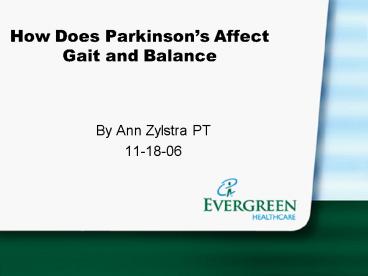How Does Parkinsons Affect Gait and Balance - PowerPoint PPT Presentation
1 / 26
Title:
How Does Parkinsons Affect Gait and Balance
Description:
Head over shoulders (over hips over feet) Hips are extended (not bent) ... Hips and knees are bent. This increases the amount of energy needed to move ... – PowerPoint PPT presentation
Number of Views:1085
Avg rating:3.0/5.0
Title: How Does Parkinsons Affect Gait and Balance
1
How Does Parkinsons Affect Gait and Balance
- By Ann Zylstra PT
- 11-18-06
2
Why does someone with Parkinson's get referred to
PT?
- 1 referral Gait and Balance
- Walking Not falling
- (difficulty walking) (imbalance / potential
to fall)
3
Difficulty Walking
- How would you
- describe this
- difficulty walking?
4
Difficulty Walking
- Slow
- Small steps
- Shuffling
- Freezing Sticky feet (cant start)
- Cant stop (Scurry and splat)
- Cant turn
5
Difficulty Walking
- Why?
- What is happening that is changing the way a
person walks?
6
Difficulty Walking
- POSTURE!
7
(No Transcript)
8
Normal Walking Posture
- Head over shoulders (over hips over feet)
- Hips are extended (not bent)
- Knees are fairly straight
- Normal stride is 2.0-2.5 ft
9
Parkinsons Posture
Original sketch for James Parkinson
the Shaking palsy 1817
Google Parkinson's posture 2006
10
Parkinsons posture
- Head forward
- Hips and knees bent
- Walking on the front of feet
11
WHY? (does Posture change with Parkinsons)
12
Rigidity
- What is Rigidity?
- Stiffness
- Inability to relax muscles
- Coordinated movement requires firing and non
firing of a muscle
13
The human anatomy
- Symmetric side to side
- Asymmetric front to back
- Designed to climb vines
14
The human anatomy
- Designed to climb vines
- Front of shoulder muscles bigger than back of
shoulder muscles - Inside of thigh bigger mm than outside of thigh
- Back of legs bigger mm then anterior of leg
15
The human anatomy
- Bigger muscles win over time
- Shoulders rotate in
- Trunk flexes forward
- Weight goes forward on the front of feet
- Tight hip adductors/ weak hip abductors
16
How does this posture effect walking?
- Forward weight shift causes firing of the muscles
of the feet and ankles - This decreases the ability to clear the foot and
reduces the step length - Hips and knees are bent
- This increases the amount of energy needed to
move - Chin comes forward to achieve horizontal gaze
- Stance narrows (scissoring cross over)
- Tight shoulder muscles
- reduces ability to swing arms
17
Balance
- Keeping our Center of gravity over our base of
support
18
Loss of balance
- Center of gravity is outside the base of support
19
Base of Support
Forward posture BOS
Normal gait BOS
Parkinson's gait BOS
20
How does Parkinson's affect balance?
- Smaller BOS (shorter steps/ narrower stance)
- COG forward (posture brings the weight forward)
- So by the definition of balance weight outside of
base fall risk
21
With Parkinsons disease the Center of Mass is in
front of the base
Smaller BOS COG forward of base
Bigger BOS Center of mass is central over BOS
22
How to improve Gait and balance?
- Stretch the big muscles
- Calf stretch
- Hamstring stretch
- Chest stretch
- Hip stretches
- Stretches should be done slowly (20-30 second
hold) and repeated 2-3 times - (1 minute per muscle)
- Stretches should be done daily
23
How to improve Gait and balance?
- Strengthen the little muscles
- Focus on the smaller muscles
- Muscles of the posterior shoulder
- Muscles outside the hips
- Muscles of the back and between the shoulder
blades - Focus on endurance
- Increased repetitions / lower weights
24
How to improve Gait and balance?
- Increase the BOS
- Bigger steps/ Wider steps
- Keep a wider base (feet 10 inches apart even with
turns) - Turn in a U if possible
- Use of Assistive walking aids
25
How to improve Gait and balance?
- Look forward not down
- Lift your toes taking longer steps
- Try strategies to decrease freezing
- Remember going faster does not safer
- Slow builds control
26
Questions?































